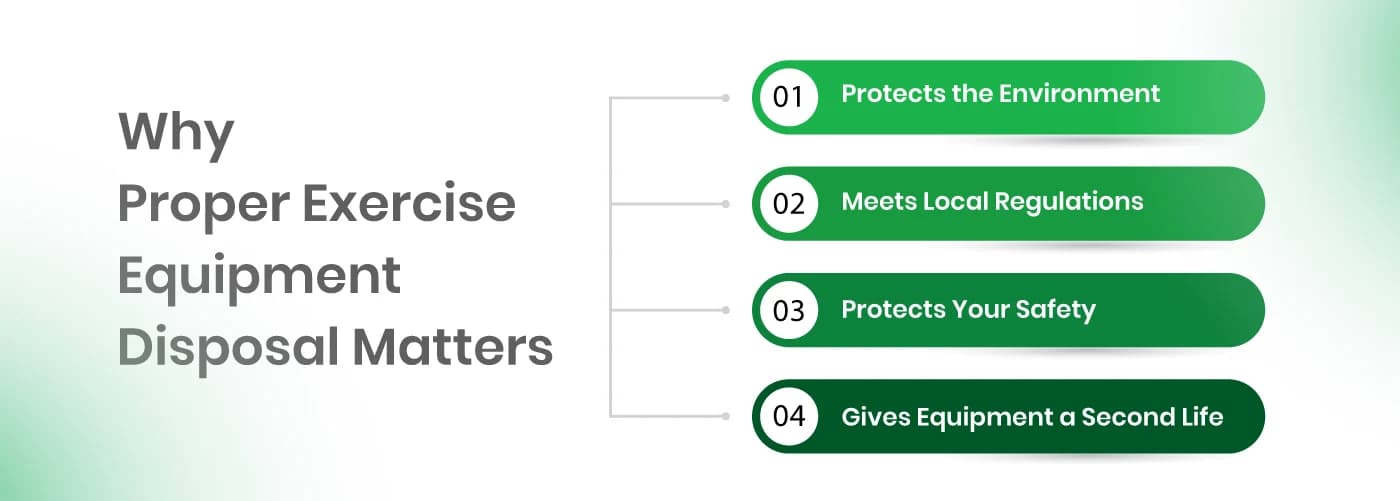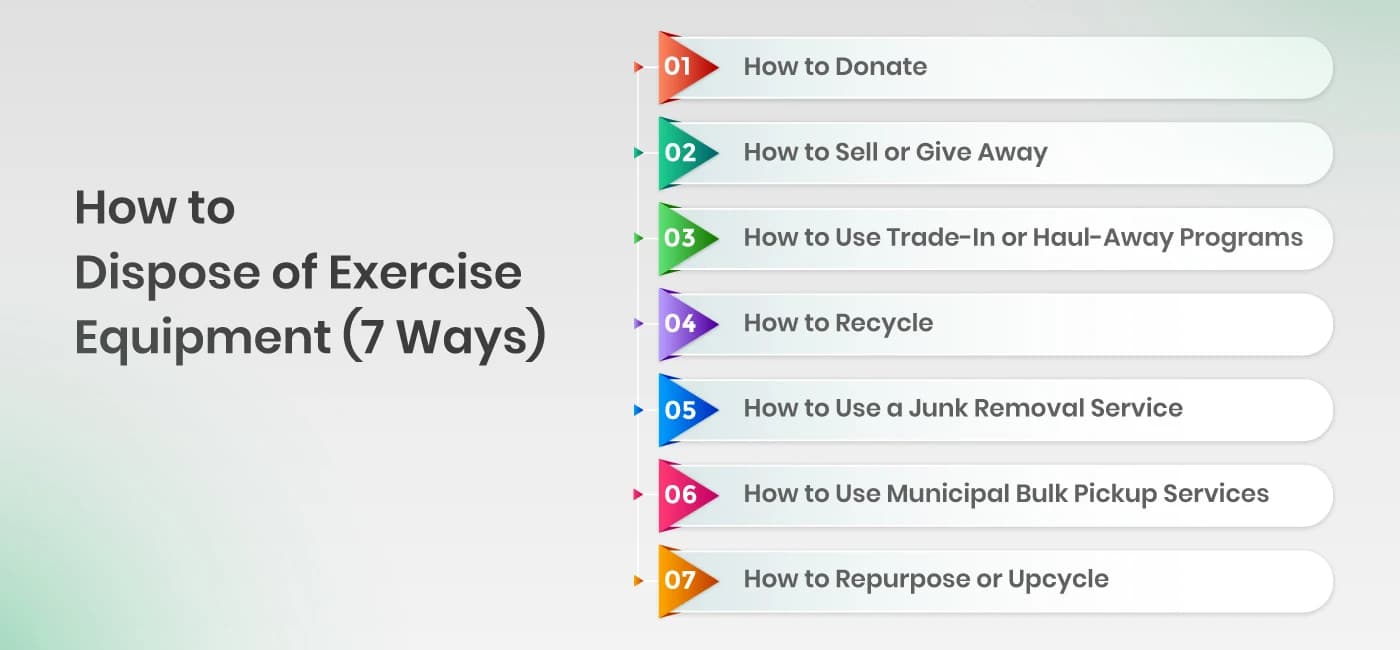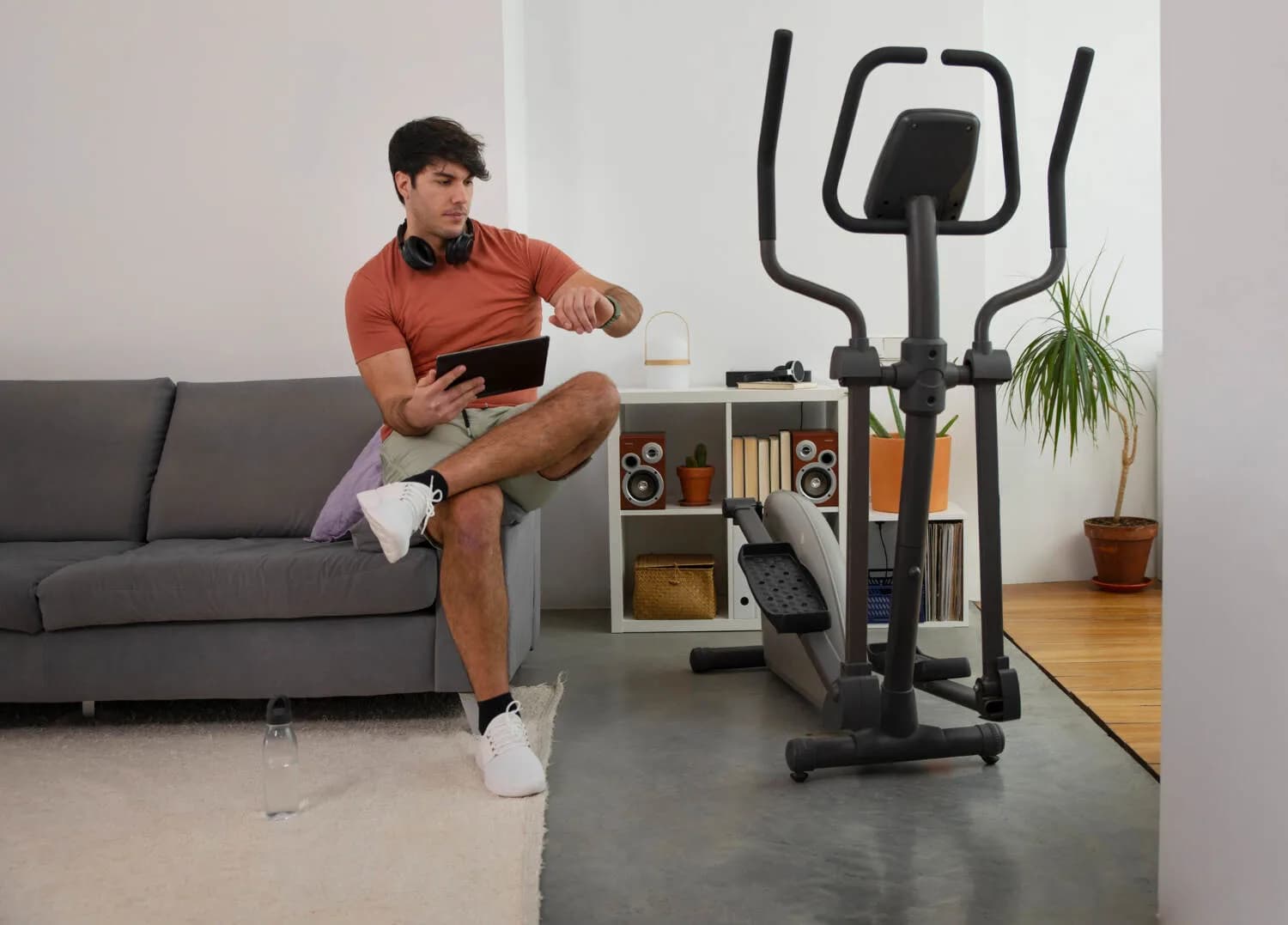BLOG / HOW TO
How to Dispose of Exercise Equipment: 7 Best Ways


Old treadmills, dusty dumbbells, and unused ellipticals have a way of turning into permanent fixtures in the corner of our homes. They’re bulky, heavy, and somehow always on the “I’ll deal with it later” list.
The problem is, getting rid of exercise equipment isn’t as simple as dragging it to the curb. Most cities won’t pick it up, and it’s not great for the environment to dump it in a landfill.
However, there are plenty of smart ways to clear out that old gear responsibly. In this guide, we’ll show you how to dispose of exercise equipment without the headache. From eco-friendly recycling and donation options to easy solutions for bulky items like treadmills and ellipticals.
Why Proper Exercise Equipment Disposal Matters 🔗

Proper exercise equipment disposal matters to protect the environment, meet local regulations, and more.
Protects the Environment 🔗
Proper disposal matters because it has an environmental impact. Modern gym gear often contains motors, wiring, and electronic components. These contribute to the growing global e‑waste problem. According to a report, the world generated 62 million tonnes of electronic waste, yet only 22.3% of it was formally collected and recycled.
That means most discarded electronics, including components from exercise equipment, end up in landfills. Where they can leach harmful chemicals like lead or mercury into the soil and water.
When you are choosing responsible exercise equipment disposal, you’re helping reduce landfill waste and ensuring valuable materials like steel and aluminum can be recycled or reused.
Learn More: How to Dispose of Your Electronics
Meets Local Regulations 🔗
Disposing of exercise machines properly also matters because most cities have strict rules about what you can put out with regular trash. Bulky items like treadmills or weight benches are often rejected by curbside pickup because of their size and weight.
If left on the curb, they can lead to fines or just sit there, creating an eyesore. You can follow approved donation or recycling options. This way, you stay compliant with local regulations and make sure your old gear is handled the right way.
Protects Your Safety 🔗
Safety is another big reason for the proper disposal of exercise equipment. A treadmill can weigh a couple of hundred pounds, and moving something that heavy without the right help or equipment can cause serious injuries.
When you use proper disposal methods like professional removal services or organized donation pickups, you avoid the physical risks and let the experts handle it safely.
Gives Equipment a Second Life 🔗
Finally, proper disposal matters because your old exercise equipment might still have value. Even if you’re done with it, someone else could use it. Donating a treadmill or set of weights keeps them out of landfills and gives them a new home with a charity, school, or community center. It’s an easy way to reduce waste while helping others.
How to Dispose of Exercise Equipment (7 Ways) 🔗

There are several ways to dispose of exercise equipment, including donating, recycling, selling, and more. Here are seven expert-approved ways to dispose of exercise equipment responsibly, safely, and sustainably.
1. Donate to Nonprofits and Community Organizations 🔗
Donating old exercise equipment is one of the most effective ways to give your treadmill, elliptical, or weight set a second life. Organizations like Habitat for Humanity ReStores, YMCAs, local schools, and senior centers often accept gently used gym gear. These donations support communities, encourage fitness, and help those who may not be able to afford new equipment.
How to Donate: 🔗
-
Check eligibility: Contact the organization to confirm they accept your type of equipment. Some centers have size or condition requirements.
-
Schedule pickup or drop-off: Many nonprofits offer free pickup, especially for bulky items. If not, prepare to transport it safely.
-
Get documentation: Ask for a donation receipt. It may qualify for a tax deduction if you itemize.
Pro Tip: 🔗
Disassemble large machines before donation. Removing pedals, handles, or motor covers makes it easier for organizations to handle and transport the equipment safely.
Authority & Credibility: 🔗
- Habitat for Humanity ReStores report that donated items are either resold or reused to support housing projects, reducing landfill waste.
- Many nonprofits follow environmental guidelines for safe reuse of large items, ensuring that usable equipment doesn’t go to waste.
2. Sell or Give Away Through Online Marketplaces 🔗

Selling or giving away your old exercise equipment online is an effective way to free up space, make some money, or help someone in need. Platforms like Facebook Marketplace, Craigslist, OfferUp, and local Buy Nothing groups connect sellers with buyers or individuals willing to pick up bulky items.
How to Sell or Give Away: 🔗
-
Take accurate measurements and photos: Provide the dimensions and condition of each part so potential buyers know exactly what they’re getting.
-
Disassemble if possible: Machines like treadmills or ellipticals are heavy and bulky. Separating rails, pedals, and motor covers makes pickup easier for both parties.
-
Set clear pickup instructions: Many buyers prefer to handle transportation themselves, which saves you effort.
-
Be safe: Meet in public areas if possible, and always have someone with you during pickups.
Authority & Credibility: 🔗
- Online marketplaces and community groups are widely recognized for enabling sustainable reuse of items, reducing landfill waste, and giving functional equipment a second life.
- According to recycling and waste management studies, reselling or giving away large items significantly reduces environmental impact by extending the product’s lifecycle.
3. Use Retailer Trade-In or Haul-Away Programs 🔗
Many fitness equipment retailers and brands offer trade-in or haul-away programs when you purchase new machines. These programs ensure your old treadmill, elliptical, or stationary bike is handled responsibly, either by recycling, refurbishing, or donating it.
How to Use Trade-In or Haul-Away Programs: 🔗
-
Check availability: You can check haul-away services when you buy new equipment. Large retailers, such as Best Buy, may also offer recycling or trade-in options for certain motorized machines.
-
Schedule pickup: Some programs require advance booking. Confirm whether disassembly is needed before pickup.
-
Prepare the equipment: Remove loose parts, unplug machines, and, if possible, partially disassemble heavy components to make transport safer.
Authority & Credibility: 🔗
- Manufacturer and retailer programs are certified to follow local waste disposal regulations, ensuring that machines are recycled or refurbished according to environmental standards.
- Trade-in programs help reduce landfill waste and recover valuable materials like metals and electronics, aligning with global sustainability goals.
4. Recycle at Certified Scrap or E-Waste Centers 🔗
When your exercise equipment is broken, outdated, or beyond repair, recycling is the most environmentally responsible option. Treadmills, ellipticals, and other machines contain valuable metals, plastics, and electronic components that should not end up in landfills.
How to Recycle: 🔗
-
Separate components: If possible, disassemble your machine into metal, plastic, and electronic parts. This makes recycling more efficient and ensures electronics are handled properly.
-
Locate certified centers: Use resources like Earth911 or your local waste management website to find certified scrap metal or e-waste facilities.
-
Drop-off or schedule pickup: Many facilities accept walk-ins, while some offer scheduled pickups for bulky items.
Pro Tip: 🔗
Always disassemble heavy or motorized machines if possible. Removing panels, wires, and belts improves safety and helps recyclers sort materials more efficiently.
Authority & Credibility: 🔗
- Certified recycling centers follow environmental and safety regulations, ensuring metals and electronics are properly reclaimed and harmful materials like batteries or wires are disposed of safely.
- Recycling preserves valuable materials such as steel, aluminum, and durable plastics, reducing the need for new resource extraction and supporting sustainable waste management.
Learn more: Eco-Friendly Junk Removal: The Complete Guide to Sustainable Waste Disposal
5. Hire a Professional Junk Removal Service 🔗

For heavy or motorized exercise equipment, professional junk removal services are often the safest and most efficient option. WeCycle handles pickup, transport, and responsible disposal, including donation or recycling of reusable parts.
How to Use a Junk Removal Service: 🔗
-
Request an estimate: Most companies provide upfront pricing based on the type and volume of equipment.
-
Schedule pickup: Choose a time when you can ensure clear access for the removal team.
-
Prepare your equipment: Disassemble heavy parts if possible, unplug machines, and remove loose components to make transport safer.
Pro Tip: 🔗
Even if the company handles disassembly, pre-disassembling components can make the pickup quicker, safer, and more efficient.
Authority & Credibility: 🔗
- Reputable junk removal companies follow local waste disposal regulations, ensuring that equipment is handled according to environmental and safety standards.
- Many services partner with charities and recycling facilities, ensuring reusable equipment is donated or recycled instead of ending up in a landfill.
- Professional removal reduces the risk of personal injury, which is especially important for heavy machines like treadmills, ellipticals, or weight benches.
Learn more: How Does Junk Removal Work
6. Check Municipal Bulk Pickup Programs 🔗
Many cities and municipalities provide bulk trash pickup or special collection services for large household items, including exercise equipment. Utilizing these programs ensures your equipment is disposed of legally and safely.
How to Use Municipal Bulk Pickup Services: 🔗
-
Check local guidelines: Visit your city or county’s waste management website to see if they accept exercise equipment and what restrictions may apply. Some cities charge a small fee or require items to be scheduled in advance.
-
Prepare the equipment: Disassemble bulky machines whenever possible. Separating metal, electronics, and plastics can help comply with municipal rules and make collection easier.
-
Schedule pickup: Follow the municipality’s instructions for drop-off or curbside collection. Make sure items are placed in approved locations on the scheduled day.
Pro Tip: 🔗
Some municipalities do not accept motorized parts. If your equipment contains electronics, consider taking motors and wiring separately to a certified e-waste facility.
Authority & Credibility: 🔗
- Municipal programs are designed to reduce illegal dumping, protect sanitation workers, and ensure materials are handled according to environmental regulations.
- Combining bulk pickup with certified recycling (for electronic components) ensures the maximum portion of your equipment is reused or properly processed, minimizing landfill waste.
Know more: Top 6 Junk Removal Tips You Need to Know
7. Repurpose or Upcycle Components 🔗
For those who enjoy DIY projects or sustainable living, old exercise equipment can be a valuable source of materials. Many parts can be creatively reused rather than discarded, giving your equipment a second life while reducing waste.
How to Repurpose or Upcycle: 🔗
-
Weight plates: Convert them into furniture bases, doorstops, or garden anchors.
-
Treadmill decks and panels: Use them for shelving, workbenches, or custom flooring projects.
-
Motors and belts: Makerspaces, robotics enthusiasts, and hobbyists often use these components for creative projects.
-
Metal frames and screws: Scrap metal can be melted down or repurposed for home projects.
Pro Tip: 🔗
Even if you don’t plan to upcycle everything, separating reusable parts before donating, selling, or recycling improves the efficiency of all disposal methods.
Authority & Credibility: 🔗
- Upcycling aligns with sustainable waste management practices by diverting reusable materials from landfills.
- Makerspaces and community workshops actively encourage the donation of old machine parts, creating educational and practical reuse opportunities.
- Disassembly is critical when properly separating metals, electronics, and plastics ensures safety and maximizes material reuse.
Conclusion 🔗
Old treadmills and ellipticals don’t have to end up as forgotten clutter. When handled the right way, they can become a resource for others and a step toward a greener environment.
By following methods like donating, recycling, or using professional removal services, you make the process safer, simpler, and eco-friendly. Disassembling parts, sorting metals and electronics, and choosing the right disposal option ensures your equipment leaves a positive impact rather than ending up in a landfill.
When you’re ready to get rid of old exercise equipment without the hassle, WeCycle can help. Our professional removal and recycling services make the process safe, easy, and environmentally responsible. Sign up today.
Frequently Asked Questions 🔗
How do I dispose of exercise equipment safely? 🔗
You can safely dispose of exercise equipment by donating functional machines, recycling broken parts at certified e-waste or scrap centers, using municipal bulk pickup programs, or hiring professional junk removal services like WeCycle. Always disassemble heavy or motorized components for safety.
Where can I dispose of a treadmill? 🔗
Treadmills can be donated to nonprofits, sold through online marketplaces, recycled at certified centers, or picked up by professional junk removal services. Some retailers and municipal programs also offer haul-away or bulk pickup for large machines.
How can I get rid of old exercise equipment for free? 🔗
Options include donating to charities, posting it for free on local marketplaces like Facebook Marketplace or Buy Nothing groups, or checking if your city offers free bulk pickup programs for large items.
Can I recycle exercise equipment? 🔗
Yes. Most machines contain metal, plastics, and electronics that can be recycled. Disassemble parts where possible and take them to certified scrap metal or e-waste facilities to ensure proper recycling.
How do I dispose of weights and small gym equipment? 🔗
Weights, dumbbells, and kettlebells can often be sold, donated, or taken to metal recycling centers. For smaller electronic equipment like rowing machines, check local e-waste programs.
How do I get rid of an elliptical machine? 🔗
Ellipticals can be donated, sold online, recycled, or removed via professional junk services. Disassembling pedals and rails makes handling and transport easier and safer.
KB Choudhury is the Chief Executive Officer of WeCycle, a technology-driven platform dedicated to transforming the recycling and waste management industry. Under his leadership, WeCycle focuses on creating efficient, data-powered solutions that simplify waste collection, promote eco-friendly practices, and support a sustainable circular economy. Choudhury’s vision for WeCycle centers on leveraging innovation and digital tools to make recycling smarter, more accessible, and impactful for both businesses and communities.
Related blogs
Quick junk removal services — find your price
Enter your zip code to see if Wecycle operates in your location.



